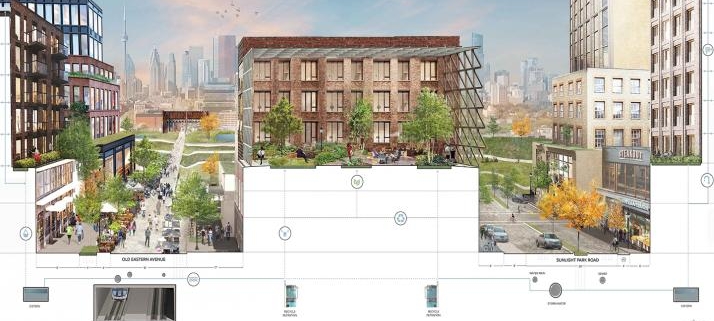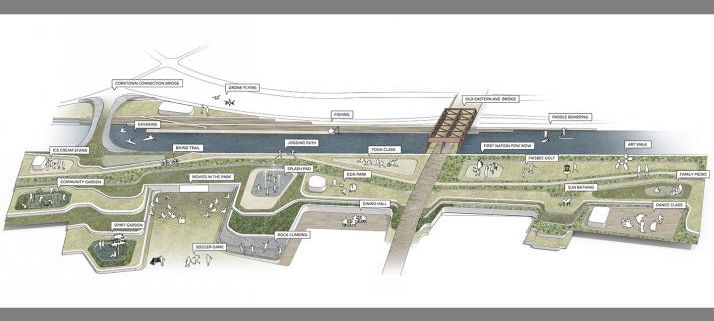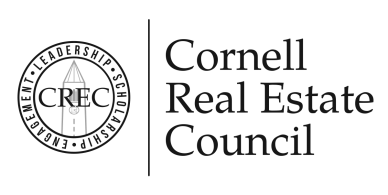Cornell Graduate Real Estate Students Win Prestigious ULI Hines Case Competition
For the first time, a multidisciplinary team of Cornell students from architecture, city and regional planning, and the Cornell Baker Program in Real Estate has won the $50,000 first prize in the annual Urban Land Institute (ULI) Gerald D. Hines Student Competition. The juried competition selected Cornell’s project from among 130 entries representing 60 universities in the U.S. and Canada.
This article was originally published on the Cornell University AAP website. You can find the original article here.

The annual competition is an urban design and development project for teams comprised of five students representing at least three disciplines. Cornell’s team included Gary Esposito (M.Arch. ’18), Paul Heydweiller (M.P.S. RE ’18), Jamie Yun Mitchell (M.Arch. ’18), Rawinthira Narksusook (M.P.S. RE ’18), and Peter Romano (M.R.P./M.P.S. RE ’19), who was the team leader. CRP’s Assistant Professor Suzanne Lanyi Charles was the faculty advisor for the team.
Download the Team’s Final Design and Financial Report
Download the Financial Pro Forma
Download the Summary Narrative
Sited this year in Toronto, the competition was “designed to simulate an actual urban planning and development scenario, and reflect developments being considered as part of the City of Toronto’s vision for reviving the neighborhoods east of its historic downtown,” according to the competition website. Participants were asked to create a master plan that redeveloped land adjacent to the Don River into a mixed-use community that would stimulate other development, including commercial, retail, and residential space, and connect residential neighborhoods in the city’s northeast section to commercial neighborhoods in the southern section.

Cornell’s project, titled Montage, is an environmentally sustainable cultural hub that integrates cinema, creative industries, and Toronto’s park system to create a unique and lively 24/7 neighborhood. According to the project description, “Akin to clipping together film scenes, Montage facilitates the collaboration of surrounding communities and creative thinkers. It promotes communication and innovation with venues for theatre and music and spaces for the public. Sunlight Park reclaims more than five acres of waterfront park space adjoining Corktown Common and provides panoramic views of downtown Toronto. Underneath the park is an engineered flood mitigation and water recycling system that uses storm water overflow to create dynamic seasonal landscapes. At the center of the development, the Nell Shipman Cinema Centre and Broadview Plaza seamlessly integrate the recreational, cultural, and professional elements of the district.”

For the preliminary stage of the competition, the team had two weeks in January to develop and submit their plan. After learning in late February that their entry had was one of four selected to continue to the finals, the team had approximately six weeks to further develop their proposal. Cornell had received honorable mentions in previous competitions, but had never made it to the finalist stage.
Charles says, “The ULI Hines competition is particularly challenging because it requires not only a highly sophisticated physical design, but also because teams need to demonstrate the financial feasibility of their ideas. Not only was this team’s design, financial analysis, and graphic presentation excellent, but their oral presentation to the jurors in Toronto was impressive. They very effectively communicated their idea and responded to some really tough questions from the jurors.”

Jury Chairman Carl Weisbrod, senior advisor at HR&A Advisors In New York City, said that Cornell’s proposal stood out because it was the most thorough and most coherent of all the presentations. “Each of the proposals had strengths and weaknesses, but the Cornell team really took a deep dive into the economics of the assignment — they prepared a market analysis, a cost analysis, an impressive financial plan and a site plan that was feasible and which worked,” he said.
The members of the team noted the importance of the interdisciplinary nature of the competition and composition of their team. Esposito says of the experience, “The ULI competition is a rare glimpse into the real world where architecture, real estate development, planning, urban design, and landscape architecture all converge on one project. The team experienced many of the same conversations between designers and developers that occur on every built project, finding the right balance of profitability and design intent to make the project work. This competition has opened many possible routes for my future, giving me a better understanding of how both development and architecture should function together.”

“The ULI Hines Student Competition was the most fulfilling learning experience I have had at Cornell and a culmination of our interdisciplinary team’s studies,” adds Heydweiller. “We put together a really strong team, and we were truly honored and humbled by the jury’s recognition of our hard work.”
This year’s jury included Carl Weisbrod, jury chairman and senior advisor at HR&A Advisors, Inc.; PaulBedford, chairman, Waterfront Toronto Design Review Panel and former Toronto chief city planner, Toronto; Robert E. Engstrom, president, Robert Engstrom Companies, Minneapolis; Merrie S. Frankel, president, Minerva Realty Consultants, LLC, New York City; Bruce Kuwabara, partner, KPMB Architects, Toronto; Raymond C. Mikulich, managing partner and chief investment officer, Ridgeline Capital Group, New York City; Sharmil Modi, Modi Adventureprises, Boston; Vicki R. Mullins, executive vice president/chief financial officer, Newland Real Estate Group, San Diego; Alex Rose, senior vice president, Continental Development Corporation, El Segundo, California; Jamie Simchik, principal, Simchik Planning and Development, Portsmouth, New Hampshire; Megan Torza, partner, DTAH, Toronto; and Leslie Woo, chief planning and development officer, Metrolinx, Toronto.

“I am in awe of what the team accomplished,” says Charles. “They had an excellent preliminary entry, but they managed to improve upon that very strong idea significantly — all while balancing the added demands of the competition with their other coursework.”
Mitchell adds, “I will remember this experience as a highlight of my time at Cornell, and as exemplary to the mission of the university to work with people of all backgrounds and fields of study to create a better world.”
Charles says it’s not too early to start thinking about next year’s competition: “At Cornell, students undertake the ULI Hines competition as part of a 1.5-credit course. I encourage all AAP graduate students in architecture and planning to consider taking part in the competition next year.”
By Rebecca Bowes





